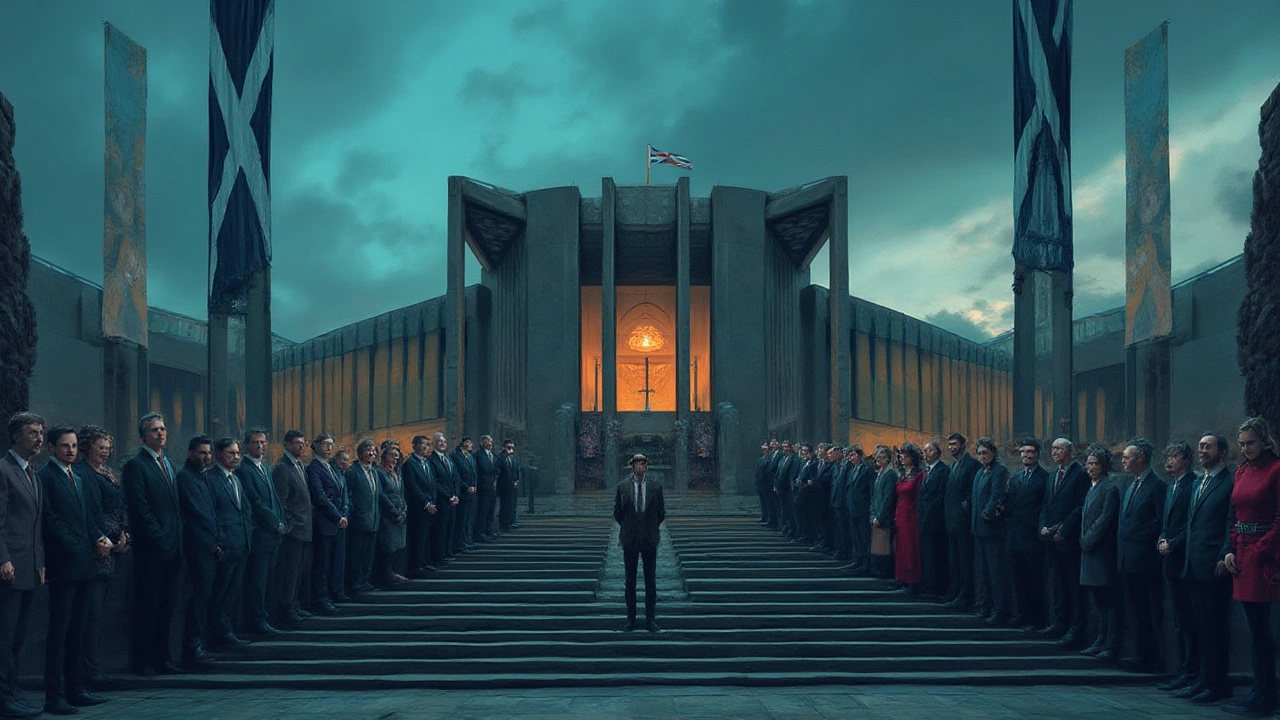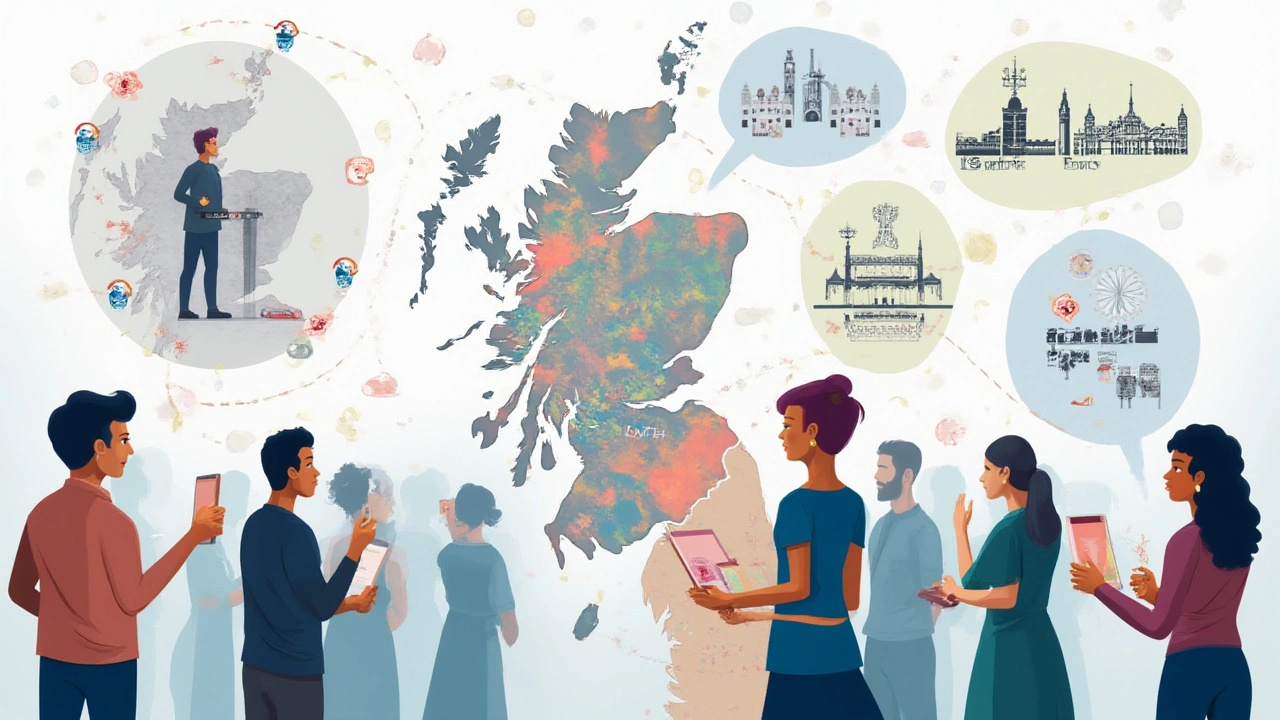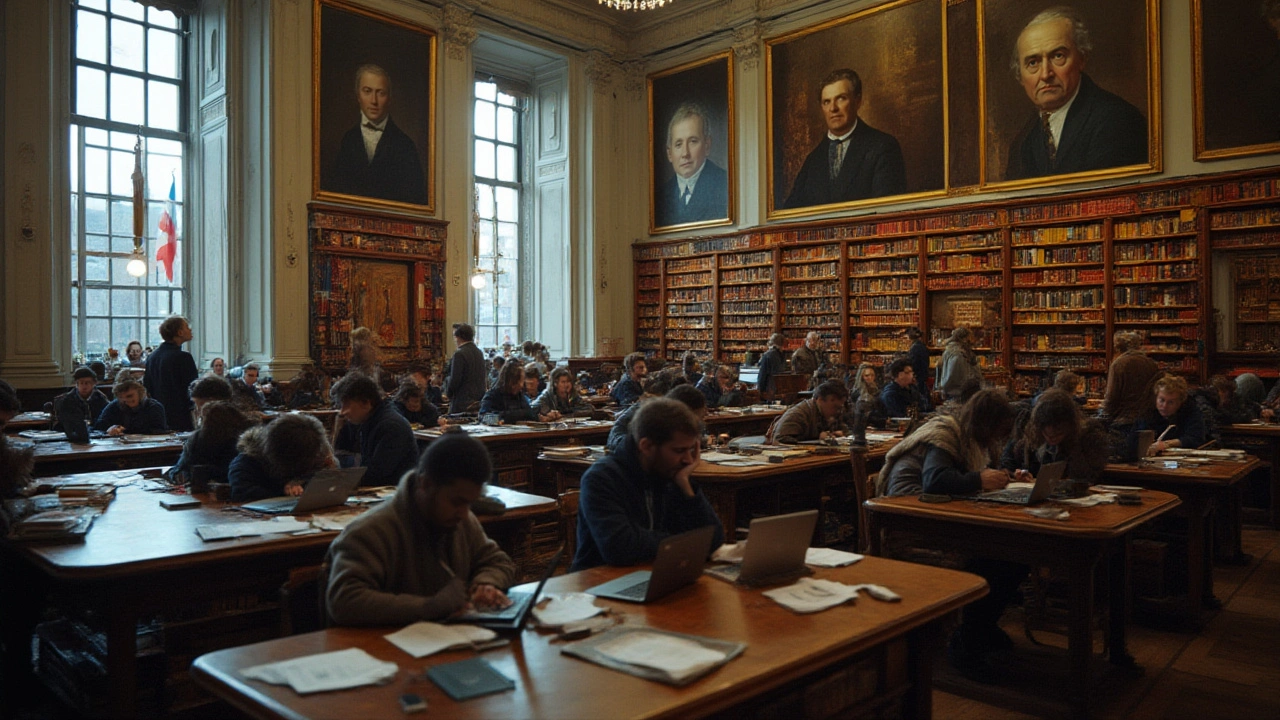
Imagine waking up in Edinburgh today and glancing at the news—no clear image of medieval kings in tartan, no clan rivalries over misty glens. Instead, debates rage online about green energy, social care, and, naturally, Scotland’s future. Back in 1320, the Declaration of Arbroath sent a warning to foreign powers: Scotland answers to no one but its people. Fast forward to 2025 and things are a whole lot more complicated. Scotland’s political landscape is now a blur of devolved powers, party rivalries, and big questions about independence. So, who really rules Scotland now?
Power Structures in Modern Scotland: Not Just Kilts and Castles
Forget the idea that a single person calls all the shots. Scotland operates under a system called “devolution.” This kicked off in 1999 when the Scottish Parliament re-opened its doors in Edinburgh after a 292-year break. Today, Scotland is still officially part of the United Kingdom, but the country gets to make most decisions about daily life. Think healthcare, education, policing, and transport—those are all decided here, not London.
The top boss is the First Minister. Right now, in 2025, that’s John Swinney from the Scottish National Party (SNP). Swinney stepped up in 2024 after Humza Yousaf resigned. The Scottish Government is a Cabinet-style setup, with ministers taking charge of health, finance, education, and more. Decisions pass through the Scottish Parliament, which works a lot like other parliaments: debates, votes, committees, the usual political wrangling.
Scotland still sends 59 MPs to Westminster for UK-level decisions, mainly on things like foreign affairs, defence, and some tax powers. It’s a balancing act—some laws start in Holyrood (the Scottish Parliament), some in the UK Parliament, and sometimes there’s friction. Striking data? In a 2025 poll by YouGov, only 27% of Scots said they think Westminster understands Scotland’s needs well. That number was even lower among 18–25-year-olds. There’s a common feeling here: “We’ll do it ourselves, thanks.”
Who’s Who: Key Political Figures and Their Roles in 2025
You’re probably wondering, who exactly holds the reins? Scotland’s most recognizable political figure right now is First Minister John Swinney. With experience dating back to the early SNP governments, he’s seen as a bridge between the party’s old guard and its younger activists. Under Swinney, the SNP has restarted calls for a second independence referendum, but recent rifts have slowed the momentum a bit.
Other heavyweights include Shona Robison, the Deputy First Minister, who also acts as Cabinet Secretary for Finance. She’s frequently quoted about Scotland’s record budget on social care and her push for net-zero targets. Then there’s Anas Sarwar of Scottish Labour—he’s the main opposition voice, calling for more investment in education and a rethink on tax rates. Douglas Ross leads the Scottish Conservatives, sticking to arguments about the economy and Scotland’s role in the UK.
One thing to watch: the Scottish Greens. They might not have the numbers the SNP do, but they’re crucial coalition partners in Parliament. Greens’ policies impact climate law, rent caps, and eco-friendly transport schemes. After all, 20% of Scottish voters under 35 say the Greens most closely match their views on social justice and the environment.
The Presiding Officer, like a referee, makes sure the Parliament runs smoothly—a bit like a schoolteacher for politicians. In 2025, Alison Johnstone still holds this role, making her one of the highest-ranking Parliament officials.

The Political Puzzle: How Parties, Parliament, and People Share Power
Every five years, Scots elect 129 Members of the Scottish Parliament (MSPs). It’s not your typical “first past the post” system; here, you get two votes—one for a local representative, and one for a party list. That means no single party usually walks away with every seat, so coalitions and collaborations are the norm. In the 2021 election (the last full one before today), the SNP won 64 out of 129 seats, just shy of a majority. Since then, they’ve leaned on the Scottish Greens to pass key laws.
Don’t forget local councils. Whether you’re in the Borders, Aberdeen, or the islands, each region has its own council that manages schools, roads, bins, and housing. Local elections use their own system, and it’s common to see independents working with party politicians to get things done. For anyone moving to Scotland, keep this in mind: your local council decides how often your bins are emptied and how much council tax you pay, not Holyrood or Westminster.
Scotland’s Parliament has power over most domestic issues, but a few big-ticket items remain in the hands of the UK government. Here’s a quick rundown:
| Area | Who Decides? |
|---|---|
| Health, Education, Justice, Environment | Scottish Parliament |
| Defence, Foreign Policy, Immigration | UK Parliament |
| Taxation (some) | Both, depending on the tax |
It’s not a perfect split. Tensions flare up, especially when the Westminster and Holyrood governments disagree—think Brexit fallout, funding for the NHS, or new gender recognition laws. These clashes show that while Scotland has a lot of autonomy, the question “Who rules Scotland?” can get murky fast.
Independence: The Ever-Present Question
The real elephant in the room—should Scotland go it alone? While the independence dream isn’t front-page every week, it’s never far. Since 2014’s “No” vote (with 55% against independence and 45% in favor), the issue has refused to fade. Every election, independence is the shadow hovering over everything. And since 2021, support has hovered in the 48–50% range.
After Brexit, things heated up. In a 2025 panel survey, nearly 53% of Scots aged 18–34 said they’d vote “Yes” if given another referendum, compared to just 39% of those aged 55 and over. That difference keeps political leaders awake at night. The SNP hasn’t managed to secure a legally binding referendum from Westminster. The UK government insists that 2014 settled it “for a generation,” while the Scottish Government claims Brexit has changed everything.
There’s also a new pro-independence party: Alba, led by Alex Salmond (yes, the former First Minister). While Alba’s presence is felt, it hasn’t yet made the electoral breakthrough to threaten the SNP-Green alliance. Meanwhile, the Scottish Liberal Democrats push for more powers but stop short of full independence, appealing mainly to central belt suburbs and rural voters in the north-east.
Arguments for independence now focus on renewable energy (Scotland produces nearly 97% of its electricity from renewables), social policy, and “getting the government we vote for.” Arguments against raise warnings about the economy, currency questions, and EU membership.

Your Daily Life: Why Knowing Who Rules Matters
Here’s where this all gets personal: the choices made by Holyrood affect almost every aspect of life in Scotland far more than most folks realize. Want free prescriptions? Thank the Scottish Parliament. Free university tuition or subsidized nursery places? Again, down to local policy. Speeding fine or a plastic straw ban? You guessed it—Scottish Government.
Even travel has its quirks. For example, if you’re a Scot aged over 60, you can take the bus for free, no matter how many trips you make. Scotland’s council tax freeze in 2024–2025 means bills stayed steady even as prices rose elsewhere in the UK—giving families some breathing room. Green energy initiatives have helped lower household energy bills, but the same tough rules mean most new homes have to follow strict eco-standards. If you’re building a house or running a B&B, you’ll see the difference.
Keen to get more involved? You can visit sittings at Holyrood, submit questions to your MSP, and even join one of the Parliament’s many committees as a citizen witness. Young people aged 16 and up can vote in all Scottish elections, which isn’t the case elsewhere in the UK. This wider franchise has made Scotland a leader in youth political engagement, with nearly 68% of 16–24-year-olds turning out for the last Holyrood election.
The future? Scotland’s path is still very much up for grabs. The Parliament keeps growing into its role, public opinion shifts with the political winds, and “who rules Scotland” might change again sooner than anyone expects. For now, most would agree: the answer isn’t a single king or prime minister, but a complex mix of politicians, parliaments, and the people of Scotland keeping everyone honest.
Comments (10)
-
Thabo mangena July 19, 2025
This is a wonderfully detailed breakdown of Scotland's political landscape in 2025. The way you highlight the shifts in power dynamics really helped me understand the subtleties behind Scotland's governance system today.
It’s fascinating to see how historical context blends with modern political ambitions to shape current leadership. From a cultural perspective, knowing who holds power informs a lot about cultural movements and societal change.
I would be curious, though, to hear more about the role of grassroots parties. Are there emerging movements that might challenge the status quo soon? Understanding this could add further depth to the political future you outline.
-
Buddy Faith July 20, 2025
Not sure I buy the rosy version of who’s really in charge in Scotland in 2025. Governments often have hidden agendas and shadow players that don’t show up in these neat summaries.
Like, sure the parties up front have their seats, but what about the influence from global powers or clandestine figures? The article seems a bit too clean-cut. We should be digging deeper here.
Anyone else suspicious of how much they’re not telling us? Transparency in politics is often just a facade.
-
Eva Monhaut July 21, 2025
I appreciate the positive tone here. Scotland’s political scene is indeed complex but full of potential for meaningful change. Especially with the rising voices advocating for social equity.
It’s encouraging to see how community engagement has grown alongside political developments, allowing more people to feel empowered in the process.
Hopefully, this trend continues to flourish in 2025 and beyond — it’s the heart of true democratic progress in any society.
Curious though, do you think the current leaders are truly representing the diversity within Scotland? Representation matters greatly in shaping inclusive policies.
-
Scott Perlman July 22, 2025
Great overview! Just to add, the system’s a bit complicated but it looks like power-sharing and coalition government could be key elements. This means decisions might lean towards compromise, which could slow radical changes.
That said, power sharing can also stabilize governance in a place with many different views, so overall it might be beneficial.
I’d love to see some speculation on how new technology influences government transparency or citizen engagement in Scotland. That angle’s pretty important today.
-
Rakesh Kumar July 23, 2025
This topic raises so many questions for me! Who exactly holds the real influence behind the scenes? Is it still the traditional parties, or are new players upset the balance?
Also, with Brexit and other geopolitical shifts, how insulated is Scotland’s political system from outside pressures? That could drastically affect outcomes in the near future.
I think understanding internal coalition dynamics would really help here. What alliances have changed recently, and what does that mean for 2025?
Would love to hear what others think about these strategic power moves.
-
Sandi Johnson July 24, 2025
Oh, absolutely enlightening this post is! Political parties and power play always make me chuckle at how serious everyone takes it all, yet the actual results seem endless debates.
Seriously though, power is fluid, and what looks solid today might be tomorrow’s punchline. Fingers crossed the politicians in Scotland get their act together instead of just posturing endlessly.
Does anyone else feel we should focus less on titles and more on actual policies impacting real people's lives? Just saying, appearances can be deceiving.
-
Bill Castanier July 26, 2025
Good post overall! For anyone interested in the grammar side of things, I noticed the guide is quite clear and well structured. Clear communication helps in understanding complex political systems.
One small nitpick would be to explore more about the interaction between Scotland’s government and the UK parliament. That relationship seems pivotal but kind of glossed over here.
Also, it'd be interesting to get an explanation of some political terminology for newcomers. Political jargon can make such articles hard to digest at times.
-
Karl Fisher July 27, 2025
Honestly, darling, this post is a somewhat dry yet necessary dive into the political power structure that Scotland is navigating. I appreciate the attempt to unmask the facade of political ideals versus real control.
However, I find it all a tad predictable — the usual party politics dressed in new suits but playing the same tired game. If you're expecting fireworks or true reform, you might be left wanting.
But hey, that's politics — a grand theater where the actors savor their scripts while the audience contemplates the subtext. Anyone else feel this is all classic showbiz?
-
mark nine July 28, 2025
Thanks for this detailed guide. As someone who keeps an eye on political frameworks globally, I can say Scotland’s system is quite interesting due to its semi-autonomous status within the UK.
The balance of power between the Scottish Parliament and Westminster continues to evolve, and this guide touches on that quite well.
I do wonder though about the practical implications of these shifts on policy-making in health and education sectors — sectors often directly affected by political change.
More on this would enrich the discussion and inform those outside Scotland better, too.
-
Tony Smith July 29, 2025
I must say, this post attempts a lofty task and fares reasonably well considering the complexity involved. The nuances of coalition dynamics, party ideologies, and leadership roles are not easy to distill simply.
Though the tone aims for clarity, some might find it overly formal given the subject matter, which is rich with intrigue and unpredictability.
Nonetheless, celebrating Scotland’s democratic landscape in this manner is commendable, and it encourages more informed discussions moving forward.
Would love to see future updates delve into the very human stories behind these political shifts — that’s where true understanding lies.
